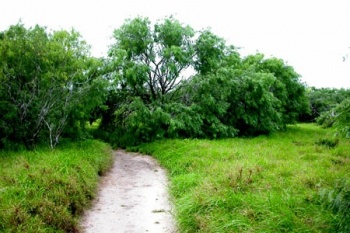| This article is incomplete. This article is missing one or more sections. You can help the BirdForum Opus by expanding it. |
Overview
The south Texas landscape is a unique blending of temperate, subtropical, coastal and desert habitats. Mexican plants and wildlife are at the northernmost edge of their range, while migrating waterfowl and Sandhill Crane fly down for the mild winters. This combination makes Laguna Atascosa National Wildlife Refuge world famous for its birds, and home to a mix of wildlife found nowhere else. Laguna Atascosa NWR is the largest protected area of natural habitat left in the Lower Rio Grande Valley, an oasis for wildlife with few alternatives. The refuge's 45,187 acres become more valuable with each acre lost to development - valuable to wildlife and those who enjoy wildlife in wildlands.
This NWR is site LTC 024 on the Great Texas Coastal Birding Trail.
Birds
Notable Species
Green Jay and Plain Chachalaca prefer the dense thorny burshland areas of the refuge, while Least Grebe and Black-bellied Whistling Duck choose the ponds and resacas.
Desert dwellers like Greater Roadrunner, Verdin, and Cactus Wren inhabit the scrub areas, while species like Roseate Spoonbill, egrets, and herons join Black-necked Stilt, American Avocet, and Piping Plover at the shore of the Laguna Madre.
In 1993 Aplomado Falcons were re-introduced at the Refuge. By 1995 the first pair to nest since 1952, were documented near Old Port Isobel Road, a few miles from the Refuge. By 2004, 900 Aplomado Falcons had been released in the Rio Grande Valley, and in 2006 25 pairs were documented nesting in the area. More information. Also look out for Groove-billed Ani.
Rare Species
Orange-billed Nightingale Thrush has occurred here once in spring 1996.
Check-list
Birds you can see here include:
To do
Other Wildlife
Ocelot, Texas tortoise, American alligators and javelina (collared peccary) occur in the Refuge.
Site Information
History and Use
The refuge was established in 1946 and comprises nearly 50,000 acres of coastal Tamaulipan brush, grasslands, lomas, and tidal flats. Management techniques are slowly replacing some of the original vegetation, destroyed by cattle ranching and agriculture in the 1800s and 1900s. Only about 5% of the original vegetation remains, but native brush for ocelot and other brushland wildlife is being replanted, wetlands are being replaced, and farming for wildlife is ongoing to help the wintering geese and sandhill cranes by leaving the entire crop for them.
Areas of Interest
- Tour roads and trails are open sunrise to sunset, daily all year.
- Lakeside Drive: only a short 1.5 miles out to the lake that gives the refuge its name.
- Bayside Drive: a semi-paved, 15-mile, one-way tour loop, passing through thorn forest and coastal prairies before reaching the Laguna Madre.
- Walking and driving trails, varying in length from 0.125 to 15 miles - see details
Access and Facilities
- The refuge is open 7 days a week from sunrise to sunset
- Visitor Center is open 8am to 4pm, 5 days a week (closed Tues. and Wed.)
- When the Visitor Center is closed, there is a self-pay kiosk with maps and information, outside the VC doors
- Restrooms open 7 days a week
- Birding tours ~ leave from Visitor Center, Thursdays to Mondays, January 6th to March 31st, 8:30am to 12 noon. Call 956-748-3607 ext. 111 to make a reservation. Cost ~ adults (16+) - $4; seniors (62+) - $3.50; under 16 - free
- Kayak tours also available - see details
- Chiggers, ticks, and rattlesnakes are found in the Refuge. Take care, if you stray off the trails into tall grass or brush.
- It can be very hot here, even in the winter months - bring plenty of water, sunscreen and insect repellent.
Entrance Fees
- General visitors, daily permit - $3 per vehicle
- A Federal Duck Stamp permits entrance to all NWRs - $15 annually, from July 1st - June 30th
- More information
Contact Details
Refuge Manager
P.O. Box 450
Rio Hondo, Texas 78583
Tel: (956) 748-3607
Email: r2rw_la@fws.gov
External Links
Content and images originally posted by Gaga





